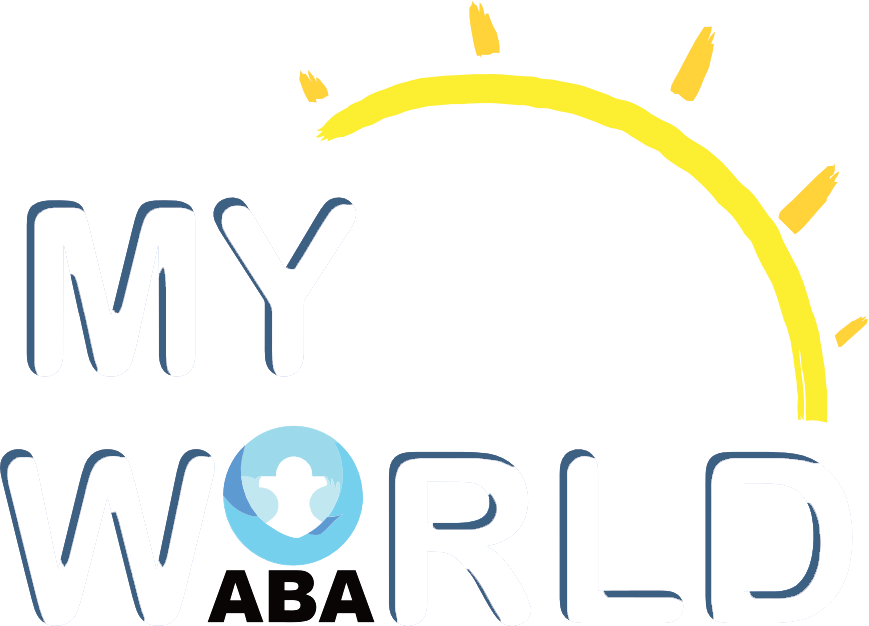Navigating an autism diagnosis can feel overwhelming. You want the best for your child: support rooted in science, delivered with compassion, and tailored to your child’s unique needs. That’s where ABA therapy comes in.
Applied Behavior Analysis (ABA) therapy is widely recognized as an effective, evidence-based approach for helping children with autism find the support they need. This approach helps children learn new skills, improve communication, and achieve greater independence. But what exactly is ABA therapy?
At My World ABA, we’re here to guide you throughout this process. This comprehensive guide aims to answer your most pressing questions about ABA therapy. You’ll learn how our team in Southwest Missouri supports families and how to get started with confidence.
Table of Contents
1. What Is ABA Therapy?
ABA therapy is designed to help children with autism and related developmental differences build essential life skills. By applying the science of learning and behavior, ABA therapy helps increase helpful behaviors and reduce other behaviors. The primary goal is to improve interactions through positive reinforcement.
Many consider ABA therapy the gold standard for autism support. It’s endorsed by leading health organizations and supported by decades of scientific research. This therapy is highly individualized, meaning each child’s program takes their personality and your family’s needs into account.

2. A Brief History of ABA Therapy
ABA therapy began with the early 20th century’s evolving understanding of human behavior. This psychological theory is called–appropriately–behaviorism. This field of study focuses on observable behavior rather than internal thoughts or feelings.
Behaviorism and Foundational Theories
The field of behaviorism was first popularized by psychologist John B. Watson in 1913. Watson argued that psychology should focus on observable behavior, influenced by environmental stimuli, rather than introspection or consciousness.
According to a Stanford University article, B.F. Skinner expanded on behaviorism in the 1930s. He introduced the concept of operant conditioning, which emphasized how rewards and punishments shape future behavior. This laid the groundwork for behavior-based interventions by showing how reinforcement modifies behavior.
Pioneers of ABA Therapy
ABA therapy was formally developed in the 1960s. Researchers Charles B. Ferster and Marian K. DeMyer conducted some of the first behavioral experiments with children with autism. They demonstrated that environmental reinforcements could gradually improve behaviors in children with developmental challenges.
The psychologist most credited with developing ABA therapy is Dr. Ole Ivar Lovaas. In the mid-1960s, Lovaas applied behaviorist principles to create an intensive, clinic-based program focused on language and social skills.
His pioneering work showed that with structured ABA therapy, children can make significant gains in communication and reduce problematic behaviors. Lovaas’s research was instrumental in popularizing ABA therapy as an effective early intervention for autism.
Now, this approach exclusively uses positive reinforcement and ethical, individualized care. It’s used worldwide in clinical, educational, and home settings to support children on the autism spectrum and their families.

3. How ABA Therapy Works at My World ABA
At My World ABA, we believe every child deserves a therapy plan as unique as they are. Our experienced team understands both the challenges and joys of raising a child with autism. Here’s what you can expect when you work with us.
Discrete Trial Training for Building Skills Step-by-Step
Discrete trial training (DTT) is a cornerstone of our ABA therapy programs. In DTT, complex skills are broken down into small, manageable steps. Each step is taught individually, using clear instructions and positive reinforcement.
Improving Communication With Verbal Behavior Intervention
Communication is at the heart of human connection. Our verbal behavior intervention focuses on helping children express their needs and wants—whether through spoken words, sign language, or communication devices.
Real Life Learning Through Natural Environment Training
We know that children learn best when skills are taught in the settings where they’ll use them. Natural environment training (NET) brings ABA therapy into real-world situations, such as mealtime, playtime, or community outings.
4. The Impact of Play-Based ABA Therapy
Children learn best when they’re having fun. That’s why play-based ABA therapy is a vital part of our approach at My World ABA. Through play, children develop social, communication, and problem-solving skills in a safe and engaging environment. Play therapy allows children to explore, create, and connect with others at their own pace.
Music and Art Therapy as Creative Outlets for Growth
Incorporating music and art into ABA therapy provides children with additional ways to express themselves and manage emotions. Singing, dancing, drawing, and painting are powerful tools for building confidence, emotional regulation, and fine motor skills.
How Self-Paced Learning Supports Each Child’s Journey
Our play-based approach ensures that each child can learn and grow at their own pace. By following the child’s interests and strengths, our behavior technicians foster motivation and a love of learning that extends beyond the therapy room.

5. What to Expect at Your First ABA Therapy Appointment
Your first visit to My World ABA is designed to be informative, supportive, and stress-free. Here’s what you can expect:
- A warm welcome from our staff and a tour of the clinic.
- A family interview to learn about your child’s strengths, challenges, and goals.
- Observation of your child in a comfortable setting.
- Collaborative discussion to set therapy goals and answer your questions.
Our team will guide you through every step, ensuring you feel confident and informed about your child’s ABA therapy journey.
6. What Makes My World ABA Stand Out
At My World ABA, we stand out by providing evidence-based, personalized ABA therapy plans tailored to each child. Our clinics offer a welcoming, inclusive environment where families and children feel comfortable and supported.
We prioritize open communication and encourage family involvement throughout the therapy process. By continuously monitoring each child’s progress, we ensure our approach delivers the best possible outcomes.

7. Three Locations in Southwest Missouri
We make ABA therapy accessible for families across Southwest Missouri. You can find us at our three convenient clinic locations, including a new building in Springfield.
My World ABA Springfield
Our flagship clinic offers comprehensive ABA therapy and support services for families in the Springfield area.
Location and Contact Information
My World ABA Joplin
This location brings the same high-quality ABA therapy to Joplin and the surrounding communities.
Location and Contact Information
My World ABA Ozark
This new facility expands access to ABA therapy to families in Ozark, staffed by a dedicated local team.
Location and Contact Information
No matter which location you choose, you’ll find a welcoming environment designed to help your child thrive.
8. Why Parents Choose My World ABA
Parents choose My World ABA because we help them better understand their child’s unique needs and strengths, while also deepening their knowledge about autism and ABA therapy. Our team empowers families to confidently communicate their child’s needs to others and ensures each child receives personalized, one-on-one support.
We believe in a collaborative approach that keeps families actively involved and informed at every stage of the therapy process. This partnership ensures parents feel supported and empowered as their child progresses and grows.

9. How to Begin Your Child’s ABA Therapy Experience
Starting ABA therapy for your child can feel like a big step. At My World ABA, we make the process easy. We’re dedicated to guiding you from your first inquiry through your child’s personalized therapy plan. Here’s how to get started.
Step-by-Step ABA Therapy Prep Checklist
- Reach Out to Our Clinic
Contact My World ABA by phone, email, or through our website to express your interest in ABA therapy for your child. Our friendly staff will answer your initial questions and help you schedule your first appointment. - Schedule an Initial Consultation and Assessment
We’ll arrange a convenient time for you and your child to visit our clinic. During this visit, our team will get to know your family, learn about your child’s strengths and needs, and conduct a thorough assessment. - Complete the Intake Process
Our staff will guide you through all necessary paperwork and explain what to expect during the assessment and therapy sessions. We’re here to answer any questions you may have about insurance, scheduling, or the ABA process. - Collaborate on Therapy Goals
After the assessment, we’ll meet with you to discuss the results and work together to set meaningful, achievable goals for your child’s ABA therapy. Your input as a parent or caregiver is essential to creating a plan that fits your family’s needs. - Develop a Personalized ABA Therapy Plan
Our team will design a customized ABA therapy program tailored to your child’s unique abilities and challenges. We’ll review the plan with you, address any concerns, and make sure you feel confident moving forward. - Begin Your Child’s ABA Therapy Journey
Once the plan is in place, your child will start working with our skilled behavior technicians. We’ll keep you updated on progress and involve you in every step, ensuring your child receives the best possible support.

10. My World ABA FAQs
Q: What does a typical ABA therapy session look like for my child at My World ABA?
A: Each session is personalized to your child’s needs and may include discrete trial training, verbal behavior intervention, and natural environment teaching. Our therapists use engaging, play-based activities to make learning enjoyable and effective.
Q: How are therapy goals set and progress measured?
A: Goals are developed collaboratively with families based on your child’s strengths and challenges. We regularly track progress using data collected during sessions and adjust the therapy plan to ensure continuous growth.
Q: How can I support my child’s learning at home and in the community?
A: Our team provides parents with strategies, training, and resources to reinforce skills learned in therapy. We encourage family involvement to help generalize skills across different settings.
Q: What qualifications do My World ABA therapists have?
A: Our therapists are highly trained professionals, including Board Certified Behavior Analysts (BCBAs) and Registered Behavior Technicians (RBTs), committed to providing compassionate, evidence-based care.
Q: How does My World ABA involve families in the therapy process?
A: We prioritize open communication and collaboration. Families participate in goal setting, receive regular updates, and are encouraged to share feedback to tailor therapy to their child’s evolving needs.

Reach Out to My World ABA
If you’re ready to learn more about ABA therapy and how it can make a difference, connect with our team. Let’s begin your child’s journey together.




